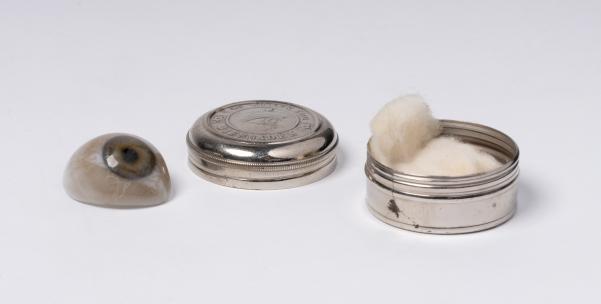Look closely at the girl in the picture.(photo 1) Which of her two eyes is fake? It's not so easy to tell, but I'll tell you that it's the one on the right. That an eye prosthesis is often hard to spot is a compliment to contemporary oculists. In the Netherlands, as many as 20,000 people wore such a glass (or plastic) eye in 2017. A small proportion of them even have two.Hans van Dam et Al, ‘Jaarverslag vereniging oog in oog,' Vereniging Oog om Oog, 2017, https://ver-ooginoog.nl/wp-content/uploads/2018/05/Jaarverslag-Ver_OOG-in-OOG-2017_webversie.pdf. At first glance, an artificial eye seems primarily an aesthetic object. It restores the appearance of someone who has undergone an eye extraction or corrects the face of one who was born without an eye or eyes to "normal." Yet appearance is far from the only reason why someone without an eye may prefer an eye prosthesis to an eye patch or nothing at all.
First, wearing an eye prosthesis helps maintain the shape of the face. With the absence of an eye, the eye socket and eyelid can sag, making them less functional.Dr. Shalu Pal, 'Benefits of Prosthetic Eyes,' http://www.drshalupal.com/view/article_4.3conx. For people who are born without an eye or eyes or have lost an eye as a child, wearing an artificial eye or conformer, a plastic shape to place in the eye socket, is even more essential. This way, the eye socket is kept in shape so that the bones in the face can develop normally.Centers for Disease Control and Prevention, ‘Facts about Anophthalmia / Microphthalmia,’ 23 oktober 2020, https://www.cdc.gov/ncbddd/birthdefects/anophthalmia-microphthalmia.html. So an artificial eye can indeed perform a physical function.
Unfortunately, another reason for choosing an eye prosthesis is the exposure to discrimination that people with a missing eye may experience.Neil Handley, "Artificial Eyes and the Artificialization of the Human Face," in Devices and Designs Medical Technologies in Historical Perspective, eds. Carsten Timmermann, Julie Anderson (London: Palgrave Macmillan, 2006), 98. People with visual impairments often face exclusion or discrimination, for example in finding employment because employers underestimate their abilities.Plus magazine, ‘Werkgevers hebben vaak een fout beeld van iemand met een visuele handicap,’ 22 september 2020, https://plusmagazine.knack.be/gezondheid/werkgevers-hebben-vaak-een-fout-beeld-van-iemand-met-een-visuele-handicap/article-normal-1644267.html#:~:text=Discriminatie%20omwille%20van%20een%20handicap,beeld%20hebben%20van%20hun%20competenties. A missing eye is very noticeable because of its location in the middle of the face, and can greatly affect the way others look at them. Therefore, it can be nice if it is not immediately visible through a prosthesis.Neil Handley, "Artificial Eyes and the Artificialization of the Human Face," in Devices and Designs
Medical Technologies in Historical Perspective, eds. Carsten Timmermann, Julie Anderson (London: Palgrave Macmillan, 2006), 98.
In addition, many people are insecure about their missing eye. Undergoing an eye extraction and the vision loss that comes with it is an emotional and impactful event in itself. In addition to the loss of vision in the lost eye, a person's mobility may also be restricted (temporarily or permanently) by the loss of depth perception. Social interaction can also be made more difficult by, for example, making eye contact. This can lead to withdrawal from social life and the development of a social anxiety disorder.Elizabeth Yuko, 'Coping With Living With One Eye,' Very well Health, 24 april 2021, https://www.verywellhealth.com/living-with-one-eye-5094342#:~:text=One%20thing%20that%20can%20help,well%20as%20dedicated%20Facebook%20groups. An eye prosthesis can improve the social aspect somewhat by masking the empty eye socket. A good eye prosthesis fits the face naturally. Thus, in many cases, contact with others is made more comfortable.Dr. Shalu Pal, 'Benefits of Prosthetic Eyes,' http://www.drshalupal.com/view/article_4.3conx.
The reasons for using an eye prosthesis are not new. At Things That Talk, for example, there is another story about eye prostheses, specifically that of Kaspar Mulder (not his real name). He was born in 1896 with two good eyes, but when he was 15 his eye was pierced by a crochet needle. The eye had to be removed and he received a glass eye from Müller and Söhne in return. The author of the story, Ester Janssen, lists several reasons why Kaspar wore the prosthesis: to look "decent," to not scare people with the empty eye socket, to improve contact with others, to give back his identity and, above all, to deceive the onlooker into believing that nothing is missing from his face. Thus, both eye prosthetics and the reasons for wearing them are timeless. Kaspar lived a full life after his accident, uninhibited by his missing eye.Ester Janssen, ‘Kunstoog,’ Things That Talk, https://thingsthattalk.net/nl/zone/Misleiden/t/ttt:TzMkCu/details.
So an eye prosthesis could provide a range of benefits in the past and also today: from better development and preservation of facial shape to less discrimination and unwanted behavior from others, more self-confidence and improved social interaction. Of course, the last, and for many people the most important, reason for getting an eye prosthesis is still aesthetic. For a person who has lost an eye, a prosthesis makes the face whole again. Their vision may be lacking, but they still want to look good! My vision, 'Ocular Prosthesis (Prosthetic Eye): Types, Care, Surgery & More,” 23 mei 2022, https://myvision.org/eye-surgery/ocular-prosthesis/.
](https://micrio.thingsthattalk.net/pnnNw/0/0-0.jpg)
